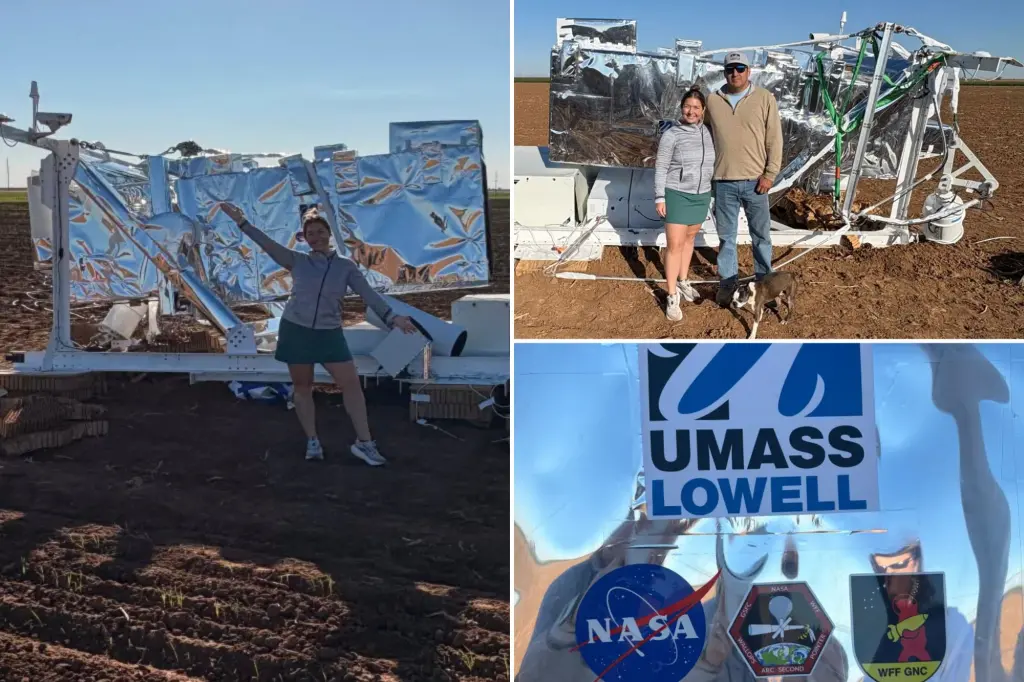NASA’s Cosmic Visitor: A Surprise Landing in West Texas
Ann Walter’s quiet day in rural West Texas took an unexpected turn when she spotted something peculiar drifting across the vast Texas sky. What initially appeared as a mysterious bulky object soon became a fascinating scientific discovery in her neighbor’s wheat field – a boxy NASA research instrument, roughly the size of an SUV, attached to an enormous parachute. “It’s crazy, because when you’re standing on the ground and see something in the air, you don’t realize how big it is,” Walter recalled with amazement. “It was probably a 30-foot parachute. It was huge.” The unexpected visitor prompted Walter to contact local authorities, who confirmed that NASA had indeed been searching for missing equipment. This chance encounter between everyday rural life and advanced space research highlights the often-overlooked intersection of cutting-edge science and ordinary American communities.
The fallen equipment belonged to NASA’s Columbia Scientific Balloon Facility, which specializes in launching large unmanned, high-altitude research balloons that travel more than 20 miles into the atmosphere to conduct scientific experiments. These balloons, launched from strategic locations like Fort Sumner, New Mexico (approximately 140 miles west of Walter’s location), carry sophisticated instruments designed to study cosmic phenomena. According to Walter’s conversation with facility personnel, this particular payload contained telescopes gathering valuable data about stars, galaxies, and black holes – essentially a space observatory floating above Earth’s atmosphere. These balloons represent an economical method for NASA to conduct certain types of astronomical research without the enormous expense of satellite launches, making them crucial components of the space agency’s scientific mission despite their relatively low profile in public awareness.
The timing of this incident coincided with the ongoing government shutdown, which affected NASA operations and made official information about the balloon mission difficult to obtain. Despite multiple attempts to reach NASA representatives and the balloon facility, messages went unreturned – a reminder of how government administrative challenges can impact scientific projects. Hale County Sheriff David Cochran confirmed that NASA officials had indeed contacted his office the previous week in their search for the missing equipment. This aspect of the story reflects the complex logistics involved in managing scientific missions, particularly those that depend on unpredictable factors like wind patterns and atmospheric conditions. Even with sophisticated tracking technologies, recovering these valuable research packages sometimes requires cooperation from local communities and authorities.
For Walter and her family in Edmonson, Texas, the landing created an unexpected connection to the nation’s space program. “The researchers came out with a truck and trailer they used to pick it up,” Walter explained, describing how NASA personnel efficiently retrieved their equipment. Before the recovery team arrived, however, Walter’s family had the opportunity to document this extraordinary visitor with photos and videos, preserving the memory of their brush with cutting-edge science. The presence of high-altitude balloon equipment in an ordinary wheat field created a striking juxtaposition – advanced astronomical research instruments surrounded by the earthy reality of agricultural Texas, worlds apart yet momentarily united in the same physical space. This convergence of cosmic exploration and everyday rural life offered a rare moment where the extraordinary touched the ordinary.
The scientific balloon program represents one of NASA’s less publicized but vital research initiatives. These balloons typically carry instruments that benefit from being above most of Earth’s atmosphere, where they can collect clearer data about cosmic phenomena without the distortion caused by air molecules and pollution. They serve as platforms for telescopes, atmospheric sampling equipment, and various experiments that might otherwise require expensive satellite deployments. The balloons themselves are marvels of engineering – enormous structures that expand to the size of sports stadiums as they rise into the thinning atmosphere, carrying payloads weighing hundreds or thousands of pounds. Their relative affordability compared to rocket launches makes them valuable tools for researchers working with limited budgets, especially for university projects and educational initiatives that partner with NASA.
For Ann Walter, what began as a puzzling sighting concluded as a memorable life experience. “It’s kind of surreal that it happened to us and that I was part of it,” she reflected, capturing the wonder that many might feel when unexpectedly participating in scientific discovery. “It was a very cool experience.” Her story reminds us that space research isn’t confined to distant launch pads or control rooms but sometimes touches down in the most unexpected places – like a wheat field in West Texas. The incident illustrates how scientific exploration extends beyond laboratories and into communities across America, occasionally creating moments of connection between ordinary citizens and the grand quest to understand our universe. While NASA continues its mission to explore the cosmos, sometimes pieces of that exploration find their way back to Earth in surprising ways, creating stories that bridge the gap between everyday life and the infinite frontier of space.


